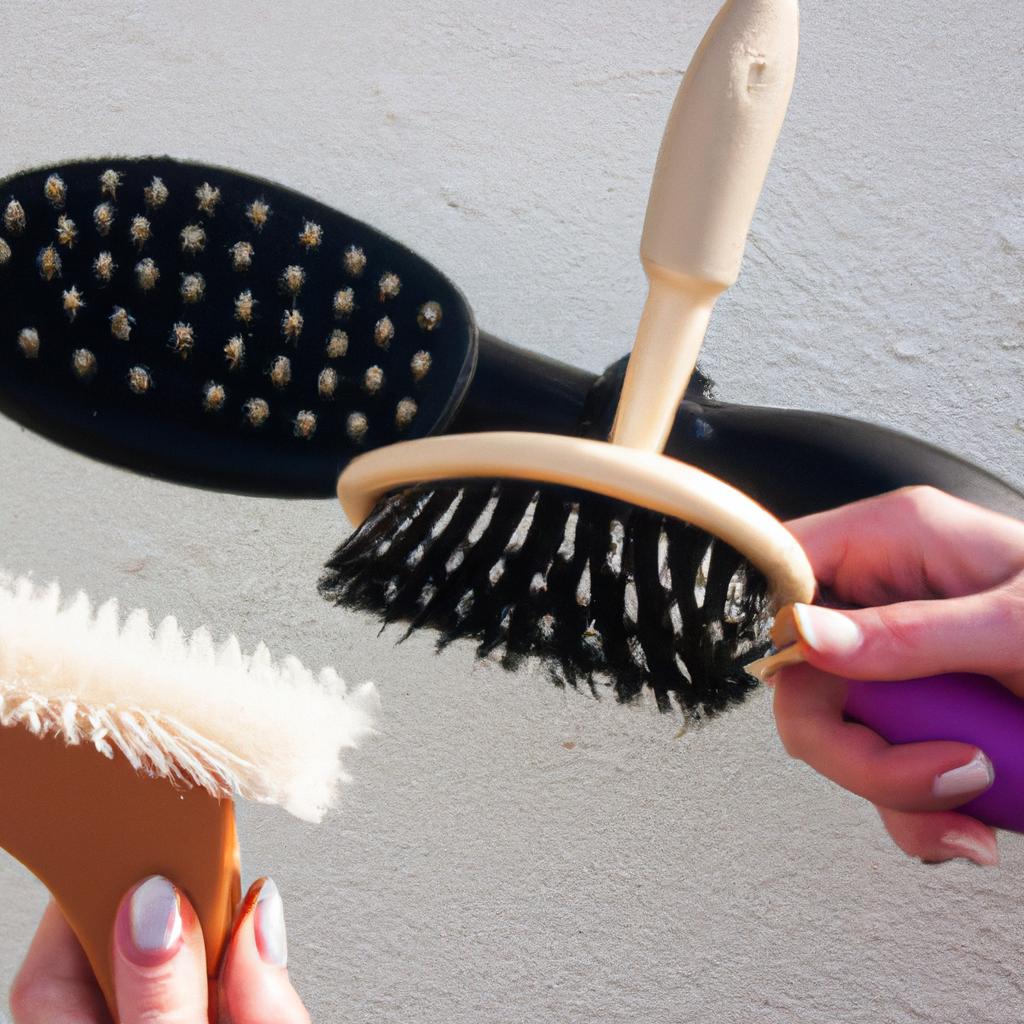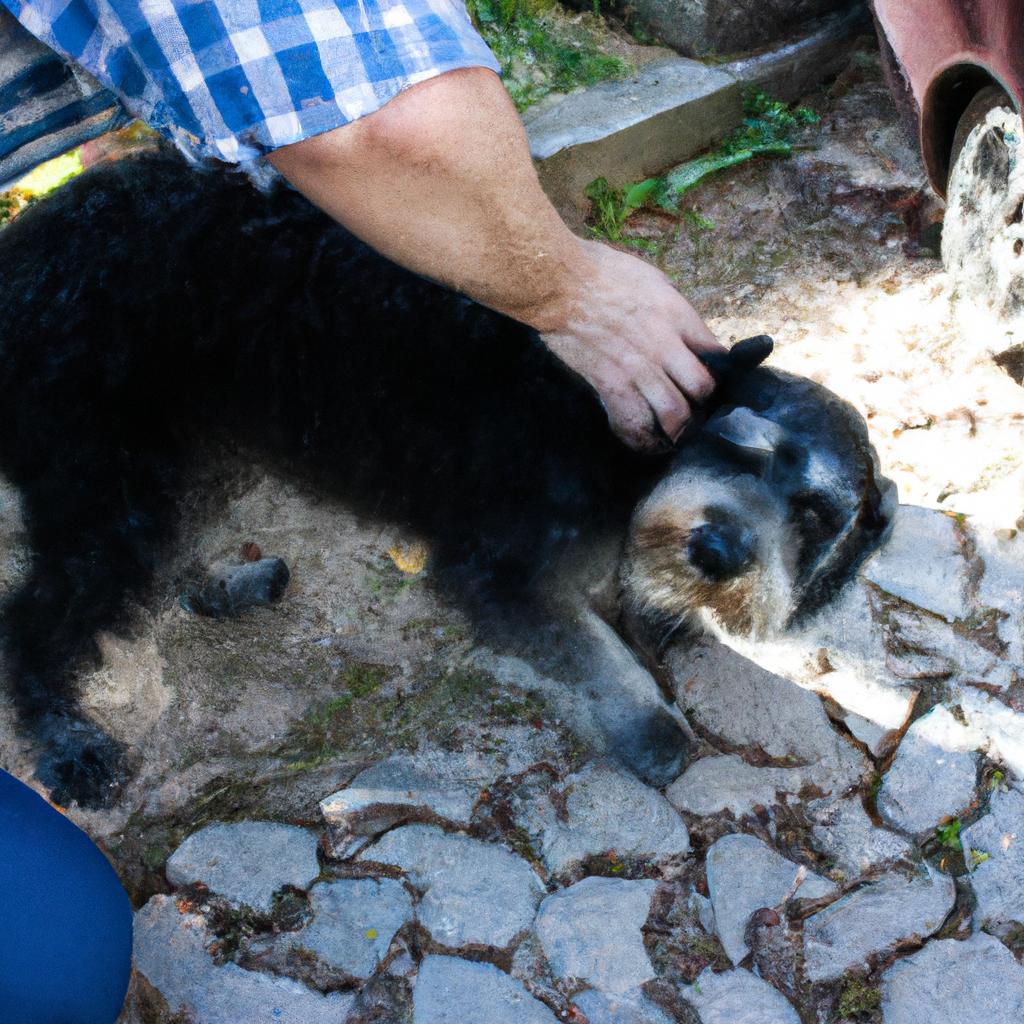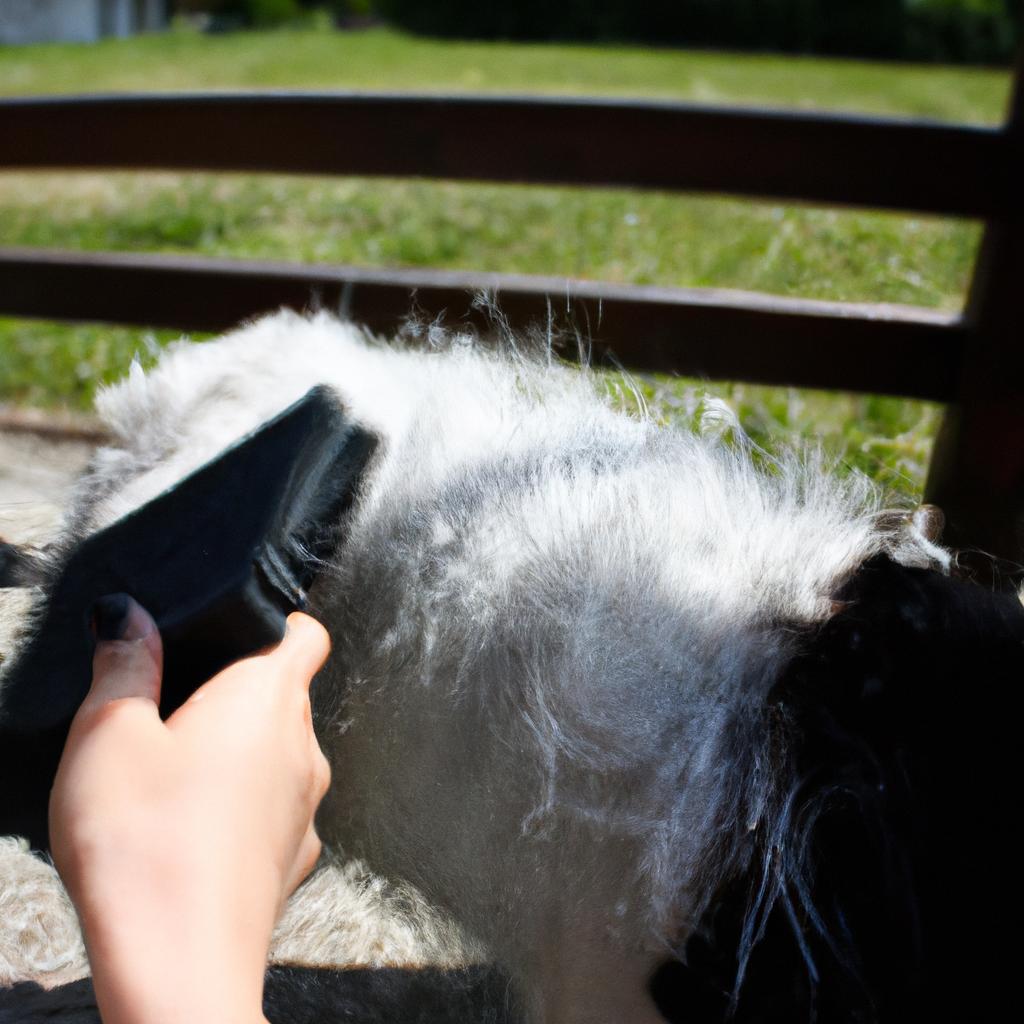Brushing Frequency: Essential Tips for Dog Grooming Salon: Coat Brushing

Dog grooming is an essential aspect of pet care, ensuring the health and well-being of our furry companions. One crucial element of dog grooming is coat brushing, which helps maintain a healthy and lustrous coat while preventing matting and tangles. To emphasize the importance of proper brushing frequency in dog grooming salons, let us consider the case study of Charlie, a Golden Retriever with long, dense fur.
Charlie’s owner diligently took him to the local dog grooming salon every month for regular brushing. However, despite these visits, Charlie developed severe matting in his fur due to infrequent at-home brushing sessions. The neglect led to discomfort and even skin irritation for poor Charlie. This example highlights that consistent and appropriate brushing frequency plays a vital role in keeping dogs’ coats healthy, emphasizing the necessity for dog groomers to educate owners on effective coat brushing techniques.
Understanding the Importance of Brushing
Imagine a scenario where Max, an adorable Golden Retriever, consistently suffers from tangled and matted fur. Despite his owner’s best efforts to maintain his coat, neglecting regular brushing sessions has led to discomfort for poor Max. This example highlights the significance of understanding why brushing is crucial for your furry companion’s overall well-being.
Regular brushing offers numerous benefits that go beyond aesthetics. Firstly, it helps prevent matting and tangling of the dog’s fur, which can be painful and cause skin irritation. By removing loose hair and preventing knots, you can ensure your dog remains comfortable and free from unnecessary discomfort.
Moreover, brushing promotes healthy blood circulation in your pet’s skin by stimulating the production of natural oils. These oils act as a protective barrier against environmental factors such as dirt, debris, and parasites. Regular brushing also allows early detection of any abnormalities or irregularities on their skin, enabling timely intervention if needed.
To emphasize the importance of brushing further:
- Regular grooming builds trust between you and your dog through bonding activities.
- Consistent brushings help reduce shedding around the house, keeping allergies at bay.
- A clean and well-groomed appearance boosts both physical and mental health for your pet.
- Brushing provides an opportunity to assess your dog’s overall condition – detecting potential health issues like infections or lumps.
| Benefits of Regular Brushing |
|---|
| Prevents matting and tangling |
| Promotes healthy blood circulation |
| Builds trust between owner and dog |
| Reduces shedding |
By recognizing these advantages that come with regular brushing sessions, you are taking proactive steps towards ensuring optimal care for your beloved canine friend.
Transitioning into the subsequent section about “Choosing the Right Brush for Your Dog,” keep in mind that not all brushes are created equal. Considering various factors such as breed type, coat length, texture, and specific grooming needs is crucial when selecting the ideal brush for your furry companion.
Choosing the Right Brush for Your Dog
Brushing your dog’s coat regularly is an essential part of maintaining their overall health and well-being. It not only keeps their fur looking clean and shiny but also helps prevent various skin issues that can arise from neglecting proper grooming practices. To illustrate this point, consider the case study of Bella, a Golden Retriever who experienced significant matting and skin irritation due to infrequent brushing.
Bella’s owner neglected regular brushing sessions for several weeks, assuming that her short-haired coat did not require much attention. However, as time passed, tangles began to form in Bella’s fur, trapping dirt and moisture close to her skin. This created an ideal breeding ground for bacteria and fungi, leading to unpleasant odors and uncomfortable itching. The lack of regular brushing had caused Bella unnecessary stress and discomfort.
To avoid such situations with your own furry companion, it is crucial to understand the importance of frequent coat brushing. Here are some key reasons why you should prioritize this aspect of grooming:
- Prevents matting: Regular brushing removes loose hair, preventing it from getting tangled or forming mats in your dog’s coat.
- Promotes healthy skin: Brushing stimulates blood circulation in the skin, distributing natural oils throughout the coat and maintaining its luster.
- Reduces shedding: Routine brushing helps control excessive shedding by removing dead hair before it falls out on furniture or clothes.
- Early detection of potential problems: Brushing allows you to closely examine your dog’s skin for any abnormalities like ticks, fleas, rashes or dry patches.
By incorporating these benefits into your understanding of the significance behind regular brushing, you can provide better care for your canine friend.
Proper Brushing Techniques
Choosing the Right Brush for Your Dog is crucial to ensure effective grooming and maintain your pet’s coat in optimal condition. Now, let’s delve into Proper Brushing Techniques that will help you achieve excellent results.
When it comes to brushing your dog, it’s essential to establish a calm and comfortable environment. Begin by gently stroking your furry friend, allowing them to become accustomed to the sensation of being touched with the brush. This initial step helps build trust between you and your dog, making the grooming process more enjoyable for both parties involved.
Once your dog is relaxed, start brushing from top to bottom using long, smooth strokes. Be sure to pay attention to areas prone to tangles or matting such as behind the ears, underarms, and around the tail. Use a combination of light pressure and firmness depending on your dog’s coat type – softer brushes for shorter hair and stiffer brushes for longer hair.
To further enhance your understanding of proper brushing techniques, here are some key points to remember:
- Always brush in the direction of hair growth.
- Remove any loose hairs or debris from the brush regularly.
- Take breaks if necessary; prolonged sessions may cause discomfort.
- If you encounter mats or tangles, use a detangling spray or seek professional assistance.
Incorporating these techniques during each grooming session will not only keep your dog’s coat healthy but also strengthen the bond between you and your beloved companion.
| Benefits of Regular Brushing |
|---|
| 1. Reduces shedding |
| 2. Improves blood circulation |
| 3. Prevents skin irritations |
| 4. Enhances natural shine |
By following proper brushing techniques consistently, you provide numerous benefits for both you and your furry friend. Next, we’ll discuss Recommended Brushing Frequency – an important aspect of maintaining a well-groomed canine companion.
Understanding how often to brush your dog is crucial in ensuring their coat remains healthy and lustrous.
Recommended Brushing Frequency
Proper Brushing Frequency: Maintaining a Well-Groomed Coat
In the previous section, we discussed the importance of using proper brushing techniques when grooming your dog’s coat. Now, let us delve into the recommended frequency at which you should brush your furry friend to keep their coat in optimal condition.
Imagine a scenario where you have a long-haired Golden Retriever named Max. Max loves exploring the outdoors and often comes back with twigs, leaves, and other debris tangled in his fur. Without regular brushing, these foreign objects can cause matting and discomfort for Max. This example illustrates why establishing a consistent brushing routine is crucial for maintaining a well-groomed coat.
To help guide you in determining how frequently you should brush your dog’s coat, consider the following factors:
- Breed: Different breeds have varying coat types that require specific maintenance. Long-haired breeds like Afghan Hounds or Shih Tzus may need daily brushing to prevent tangles and mats, while short-haired breeds such as Boxers or Labradors generally require less frequent brushing.
- Coat Length: The length of your dog’s hair plays a role in determining how often they should be brushed. Generally, dogs with shorter coats may only need weekly brushing sessions, whereas those with longer coats will benefit from more frequent attention.
- Lifestyle: Dogs that spend most of their time indoors typically shed less than those who enjoy outdoor activities regularly. Regular brushing helps remove loose fur and reduces shedding, especially during seasonal changes.
- Individual Needs: Some dogs have underlying health conditions or allergies that affect their skin and coat health. It is advisable to consult with your veterinarian if you suspect any issues so they can provide personalized recommendations on appropriate brushing frequency.
- Regularly grooming your dog strengthens the bond between you both.
- Proper brushing prevents painful matting and tangling of fur.
- Frequent brushing aids in early identification of skin issues or parasites.
- A well-groomed coat enhances your dog’s overall appearance and hygiene.
Additionally, here is a three-column table highlighting the benefits of regular brushing:
| Benefits | Description |
|---|---|
| Reduces shedding | Less fur around the house and on furniture |
| Stimulates blood circulation | Promotes healthier skin and hair growth |
| Prevents matting and tangling | Avoids discomfort and potential skin irritation |
| Early detection of abnormalities | Allows for timely treatment of any underlying issues |
By establishing a consistent brushing routine tailored to your dog’s specific needs, you can ensure that their coat remains healthy, free from tangles, and comfortable. In our next section, we will shift focus towards identifying common problems that may occur with your dog’s coat, providing insights on how to address them effectively.
Identifying Common Coat Problems
Building on the importance of recommended brushing frequency, let us now delve into identifying common coat problems that can arise if grooming practices are not followed diligently.
To understand the potential issues that may occur without regular and proper brushing, we will discuss a case study highlighting the impact of neglecting to maintain a dog’s coat. Imagine a scenario where a pet owner fails to brush their long-haired dog for an extended period. As time passes, the neglected fur becomes matted and tangled, leading to discomfort and skin irritation for the canine companion. This example illustrates how inadequate brushing can result in various coat-related problems.
To further highlight these challenges, here are some key points to consider:
- Neglecting regular brushing can lead to matting and tangling of your dog’s coat.
- Matting restricts airflow to the skin, potentially causing discomfort and even skin infections.
- Without frequent brushing, shedding hair accumulates within the coat, forming clumps that could be uncomfortable for your furry friend.
- Lack of proper grooming may also hide underlying health issues such as parasites or skin conditions.
Let’s take a moment to examine this information visually through a table showcasing four common coat problems caused by insufficient brushing:
| Common Coat Problem | Description |
|---|---|
| Matting | Tangled clumps of hair that form due to lack of consistent brushing |
| Skin Irritation | Discomfort or inflammation caused when mats restrict airflow |
| Shedding Accumulation | Build-up of shed hair within the unmaintained coat |
| Hidden Health Issues | Underlying ailments like parasites or skin conditions masked by poor grooming habits |
By understanding these potential consequences, you can see why maintaining proper brushing frequency is crucial for your dog’s overall well-being.
Now that we have explored common coat problems arising from inadequate grooming practices, let us move on to the subsequent section on maintaining a healthy coat.
Maintaining a Healthy Coat
Understanding common coat problems is crucial in maintaining your dog’s overall health and appearance. Once these issues have been identified, it becomes essential to establish an effective brushing routine that can help prevent or alleviate them. In this section, we will explore key tips to ensure proper coat brushing techniques at home.
Example:
To illustrate the importance of regular brushing, let’s consider a hypothetical case study involving Bella, a long-haired Golden Retriever. Bella’s owner neglected her grooming needs, leading to severe matting and skin irritations. However, after implementing a consistent brushing regimen using appropriate tools and techniques, Bella’s coat improved significantly, restoring her comfort and overall well-being.
Proper brushing technique includes the following guidelines:
-
Use suitable brushes and combs:
- Slicker brushes effectively remove loose fur and detangle mats.
- Bristle brushes are ideal for distributing natural oils throughout the coat.
- Dematting tools help gently untangle stubborn mats without causing discomfort.
- Undercoat rakes effectively remove loose undercoat hair.
-
Establish a regular schedule:
- Determine your dog’s specific breed requirements for brushing frequency.
- Dogs with longer coats generally require more frequent brushing sessions.
- Consider factors such as shedding patterns and activity levels when setting a schedule.
- Aim for consistency to maintain a healthy coat condition over time.
-
Pay attention to sensitive areas:
- Carefully brush around delicate areas like ears, armpits, groin, and tail base.
- These regions tend to accumulate dirt, debris, or develop tangles more easily.
- Be gentle yet thorough while ensuring your dog remains comfortable throughout the process.
-
Monitor for signs of discomfort or pain:
- Watch for any indications that your dog may be experiencing discomfort during brushing.
- Signs such as excessive pulling away, vocalizing, or sudden aggression require attention.
- If necessary, consult a professional groomer or veterinarian to address any underlying issues.
To further enhance your understanding of proper coat brushing techniques, the following table provides an overview of recommended brushes and their specific uses:
| Brush Type | Description | Ideal For |
|---|---|---|
| Slicker brush | Fine wire bristles | Removing loose fur and detangling |
| Bristle brush | Natural bristles | Distributing natural oils |
| Dematting tool | Multiple blades with sharp edges | Gently untangling stubborn mats |
| Undercoat rake | Wide-spaced teeth or blades | Removing loose undercoat hair |
By adhering to these guidelines and utilizing suitable tools, you can ensure effective grooming sessions that promote a healthy coat for your beloved companion.
In summary, establishing a consistent brushing routine tailored to your dog’s specific needs is vital in preventing common coat problems from developing. By using appropriate brushes, maintaining regular schedules, paying attention to sensitive areas, and monitoring signs of discomfort, you can keep your furry friend’s coat in optimal condition and contribute to their overall well-being.






